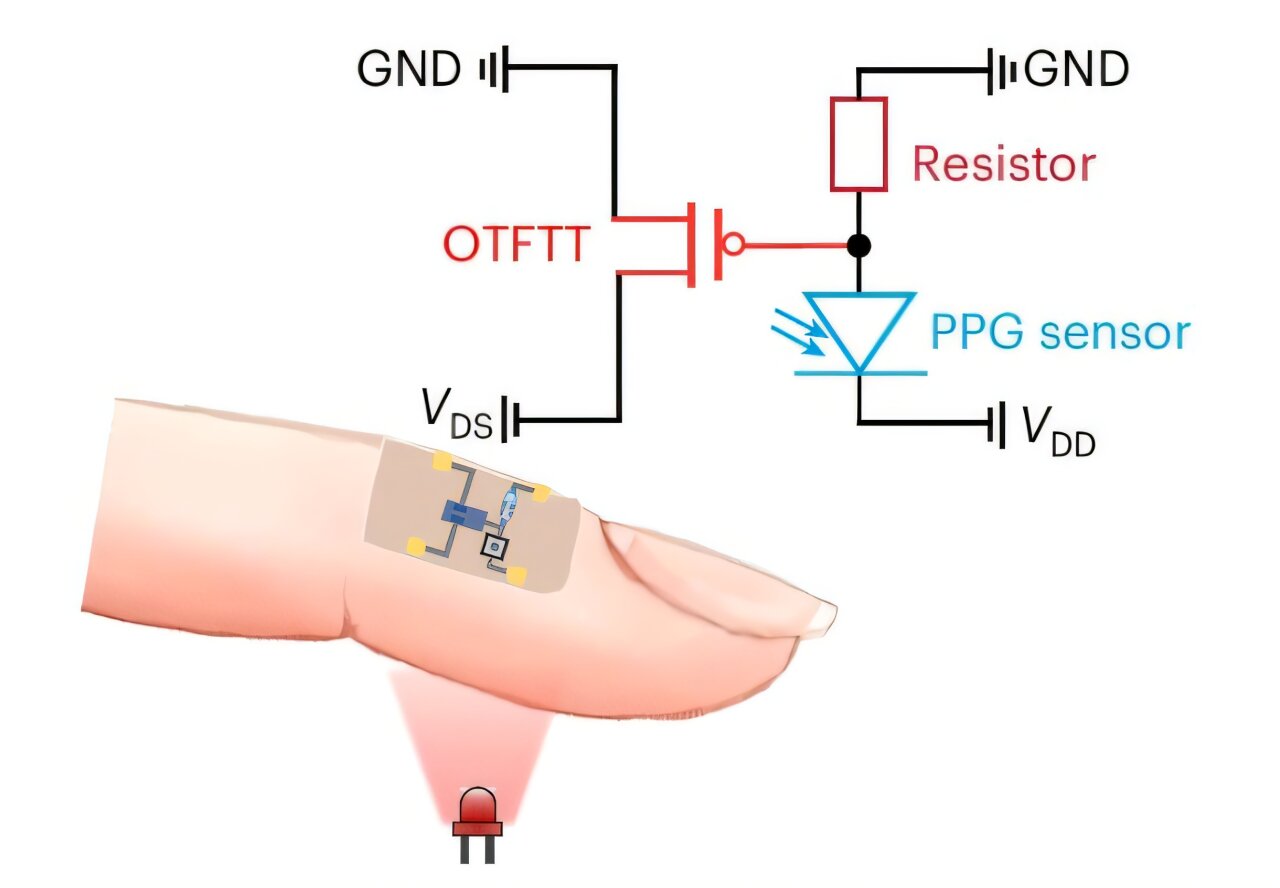Tech
New organic thin-film tunnel transistors for wearable and other small electronics

To meet the growing demands of flexible and wearable electronic systems, such as smart watches and biomedical sensors, electronics engineers are seeking high-performance transistors that can efficiently modulate electrical current while maintaining mechanical flexibility.
Thin-film transistors (TFTs), which are comprised of thin layers of conducting, semiconducting and insulating materials, have proved to be particularly promising for large-area flexible and wearable electronics, while also enabling the creation of thinner displays and advanced sensors.
Despite their potential, the energy-efficiency with which these transistors can switch electrical current has proved difficult to improve. This is due to the so-called thermionic limit, a theoretical threshold that delineates the lowest possible voltage required for a transistor to boost electrical current by a factor of 10 at room temperature when switching between “off” and “on” states.
Researchers at Soochow University and other institutes have developed a new TFT based on organic materials that could bypass this limitation, as it operates below the thermionic limit. The transistor, introduced in a paper published in Nature Electronics, was found to amplify signals with remarkable efficiency.
“Our work was driven by a fundamental challenge in wearable electronics and Internet of Things (IoT): the pursuit of high-performance devices with ultra-low-power consumption,” Jiansheng Jie, senior author of the paper, told Tech Xplore.
“Conventional organic thin-film transistors (OTFTs) are inherently limited by the thermionic emission mechanism, which sets a theoretical minimum for the subthreshold swing (SS)—a key metric that determines how efficiently a transistor can switch—of 60 mV dec-1 at room temperature. This inherent limitation results in excessive power dissipation during switching operations, posing a major barrier to energy-efficient operation.”
This recent study builds on recent works that highlighted the promise of so-called tunnel field-effect transistors (TFETs) based on inorganic semiconductors. These transistors were found to overcome the limitations of conventional transistors, leveraging a quantum mechanical process known as band-to-band tunneling.
“We sought to translate these advantages into the field of organic electronics,” said Jie. “Our central objective was to develop organic thin-film tunnel transistors (OTFTTs) capable of sub-60 mV dec-1 performance, thereby breaking the fundamental thermionic limit that has long governed conventional OTFTs.
“By demonstrating such behavior in a solution-processable, flexible organic platform, our research addresses a critical gap in the technological evolution of organic electronics and paves the way toward low-voltage, highly efficient flexible circuits for next-generation wearable and IoT applications.”
The new OTFTT developed by the researchers replaces the thermionic injection mechanism that drives the operation of conventional TFTs with band-to-band tunneling. This process allows charge carriers to pass through the energy barrier directly and at extremely low voltages, significantly boosting the devices’ switching efficiency.
“The key innovation lies in the design of a hybrid inorganic-organic source-channel heterojunction,” explained Jie.
“We combined molybdenum trioxide (MoO3), an inorganic metal oxide with a deep-conduction-band, with the 2,7-dioctyl[1]-benzothieno[3,2-b][1]benzothiophene (C8-BTBT) single-crystalline thin film, which has a relatively low highest occupied molecular orbital (HOMO) energy level. This creates a ‘broken-gap’ alignment, where the HOMO of C8-BTBT lies above the conduction band (CB) of MoO3.”

The configuration of the team’s transistor prompts the thermally excited tail of carriers originating from the MoO3 source to be sharply truncated. This in turn effectively suppresses classical thermionic emission processes, making band-to-band tunneling the dominant carrier injection mechanism.
“Meanwhile, by introducing a molecular decoupling layer (BPE-PDCTI) at the heterojunction interface, the Fermi-level pinning effect was effectively alleviated and the tunneling barrier height was further reduced,” said Jie.
“This strategic design enables the device to trigger charge band-to-band tunneling at an extremely low supply voltage. As a result, our OTFTTs overcame the 60 mV dec-1 thermionic limit on SS, achieving the lowest SS of 24.2 ± 5.6 mV dec-1 among the existing thin-film transistor technologies, alongside the record-high signal amplification efficiency of 101.2 ± 28.3 S A-1.”
The ultra-low SS yielded by the newly developed transistor is highly favorable for the development of low-power signal amplification circuits. In initial tests, circuits based on the transistor were found to achieve a gain in amplification of over 537 V V−1 at an ultra-low power consumption below 0.8 nW.
“Our OTFTTs break the fundamental thermionic limit—a long-standing theoretical ceiling on SS (60 mV dec⁻¹ at room temperature) that has constrained the energy efficiency of conventional thin-film transistors for decades,” said Jie.
“This breakthrough not only redefines the performance boundaries of organic electronics but also enables a new class of ultra-low-power devices. The practical implications are substantial. Our OTFTTs are ideally suited for energy-constrained applications such as wearable health monitors, implantable biosensors, and self-powered IoT nodes.”
Notably, the OTFTT developed by Jie and his colleagues is compatible with existing processing and electronics fabrication strategies. In the future, it could be improved further and used to develop a wide range of high precision sensing devices, including trackers for the diagnosis or monitoring of specific medical conditions, environmental sensing systems and neuromorphic (brain-inspired) computing hardware.
“In bridging the gap between the intrinsic physical limitations of organic semiconductors and the stringent efficiency demands of next-generation technologies, this work represents a critical step toward intelligent, pervasive, and environmentally benign electronic systems,” said Jie.
Other researchers could soon build on the team’s design and set out to develop similar OTFTTs. Meanwhile, Jie and his colleagues plan to continue improving their device, for instance, by optimizing its performance via the careful engineering of energy levels at the interface between the organic materials it is based on.
To do this, they will select organic semiconductors with reduced bandgaps and lower carrier effective mass, while also creating high-conductivity interfacial decoupling layers that could enhance the transistor’s tunneling efficiency and performance.
“We will also expand the technology to n-type OTFTTs to enable all-organic tunneling logic circuits, addressing the current gap in low-power organic logic applications,” added Jie.
“Moreover, we plan to deploy OTFTTs in high-precision biomedical signal amplification (e.g., EEG, EMG), ultra-sensitive environmental sensing (e.g., trace gas detection, low-light imaging), and low-power IoT signal processing.
“Finally, we will continue developing scalable integration techniques for the large-scale fabrication of the OTFTTs on flexible substrates, aiming to accelerate the industrial adoption of high-performance, energy-efficient organic electronic systems.”
Written for you by our author Ingrid Fadelli, edited by Sadie Harley, and fact-checked and reviewed by Robert Egan—this article is the result of careful human work. We rely on readers like you to keep independent science journalism alive.
If this reporting matters to you,
please consider a donation (especially monthly).
You’ll get an ad-free account as a thank-you.
More information:
Wei Deng et al, Organic thin-film tunnel transistors, Nature Electronics (2025). DOI: 10.1038/s41928-025-01462-7.
© 2025 Science X Network
Citation:
New organic thin-film tunnel transistors for wearable and other small electronics (2025, October 22)
retrieved 22 October 2025
from https://techxplore.com/news/2025-10-thin-tunnel-transistors-wearable-small.html
This document is subject to copyright. Apart from any fair dealing for the purpose of private study or research, no
part may be reproduced without the written permission. The content is provided for information purposes only.
Tech
The Disney-OpenAI Deal Redefines the AI Copyright War

On Thursday, Disney and OpenAI announced a deal that might have seemed unthinkable not so long ago. Starting next year, OpenAI will be able to use Disney characters like Mickey Mouse, Ariel, and Yoda in its Sora video-generation model. Disney will take a $1 billion stake in OpenAI, and its employees will get access to the firm’s APIs and ChatGPT. None of this makes much sense—unless Disney was fighting a battle it couldn’t win.
Disney has always been a notoriously aggressive litigant around its intellectual property. Alongside fellow IP powerhouse Universal, it sued Midjourney in June over outputs that allegedly infringed on classic film and TV characters. The night before the OpenAI deal was announced, Disney reportedly sent a cease-and-desist letter to Google alleging copyright infractions on a “massive scale.”
On the surface, there appears to be some dissonance with Disney embracing OpenAI while poking its rivals. But it’s more than likely that Hollywood is embarking down a similar path as media publishers when it comes to AI, signing licensing agreements where it can and using litigation when it can’t. (WIRED is owned by Condé Nast, which inked a deal with OpenAI in August 2024.)
“I think that AI companies and copyright holders are beginning to understand and become reconciled to the fact that neither side is going to score an absolute victory,” says Matthew Sag, a professor of law and artificial intelligence at Emory University. While many of these cases are still working their way through the courts, so far it seems like model inputs—the training data that these models learn from—are covered by fair use. But this deal is about outputs—what the model returns based on your prompt—where IP owners like Disney have a much stronger case
Coming to an output agreement resolves a host of messy, potentially unsolvable issues. Even if a company tells an AI model not to produce, say, Elsa at a Wendy’s drive-through, the model might know enough about Elsa to do so anyway—or a user might be able to prompt their way into making Elsa without asking for the character by name. It’s a tension that legal scholars call the “Snoopy problem,” but in this case you might as well call it the Disney problem.
“Faced with this increasingly clear reality, it makes sense for consumer-facing AI companies and entertainment giants like Disney to think about licensing arrangements,” says Sag.
Tech
Cursor Launches an AI Coding Tool For Designers

Cursor, the wildly popular AI coding startup, is launching a new feature that lets people design the look and feel of web applications with AI. The tool, Visual Editor, is essentially a vibe-coding product for designers, giving them access to the same fine-grained controls they’d expect from professional design software. But in addition to making changes manually, the tool lets them request edits from Cursor’s AI agent using natural language.
Cursor is best known for its AI coding platform, but with Visual Editor, the startup wants to capture other parts of the software creation process. “The core that we care about, professional developers, never changes,” Cursor’s head of design, Ryo Lu, tells WIRED. “But in reality, developers are not by themselves. They work with a lot of people, and anyone making software should be able to find something useful out of Cursor.”
Cursor is one of the fastest growing AI startups of all time. Since its 2023 debut, the company says it has surpassed $1 billion in annual recurring revenue and counts tens of thousands of companies, including Nvidia, Salesforce, and PwC, as customers. In November, the startup closed a $2.3 billion funding round that brought its valuation to nearly $30 billion.
Cursor was an early leader in the AI coding market, but it’s now facing more pressure than ever from larger competitors like OpenAI, Anthropic, and Google. The startup has historically licensed AI models from these companies, but now its rivals are investing heavily in AI coding products of their own. Anthropic’s Claude Code, for example, grew even faster than Cursor, reaching $1 billion in annual recurring revenue just six months after launch. In response, Cursor has started developing and deploying its own AI models.
Traditionally, building software applications has required many different teams working together across a wide range of products and tools. By integrating design capabilities directly into its coding environment, Cursor wants to show that it can bring these functions together into a single platform.
“Before, designers used to live in their own world of pixels and frames, and they don’t really translate to code. So teams had to build processes to hand off tasks back and forth between developers and designers, but there was a lot of friction,” says Lu. “We kind of melded the design world and the coding world together into one interface with one AI agent.”
AI-Powered Web Design
In a demo at WIRED’s San Francisco headquarters, Cursor’s product engineering lead Jason Ginsberg showcased how Visual Editor could modify the aesthetics of a webpage.
A traditional design panel on the right lets users adjust fonts, add buttons, create menus, or change backgrounds. On the left, a chat interface accepts natural-language requests, such as “make this button’s background color red.” Cursor’s agent then applies those changes directly into the code base.
Earlier this year, Cursor released its own web browser that works directly within its coding environment. The company argues the browser creates a better feedback loop when developing products, allowing engineers and designers to view requests from real users and access Chrome-style developer tools.
Tech
AT&T Gives the Smart Home a Second Try With Help From Google and Abode

AT&T is taking a second crack at the smart home. After sunsetting its Digital Life service in 2022—powered by the now-defunct 3G network—the company is launching a new smart-home security platform called Connected Life, this time in partnership with smart-home players Google and Abode.
Previously available as a pilot program in select markets, AT&T Connected Life is rolling out nationwide starting today. The vision behind it is to simplify smart-home setup. Instead of buying various smart-home devices and using multiple apps to connect them, you can buy one of two kits directly from AT&T’s Connected Life website—the Starter Kit ($11 per month for 36 months) or the Advanced Kit ($19 per month for 36 months). You can also pay upfront for the kits at $399 and $699, respectively.
Each includes Google Nest smart-home products and security sensors, with the Advanced Kit offering more sensors, a security keypad, and a Nest Cam security camera. (Google confirmed the Nest products on offer are not the latest devices the company launched recently.) You’ll use the Connected Life app and the Google Home app to set everything up, though you can also get help from a technician if you don’t want to DIY.
Google says the platform leverages Google Home’s application programming interface (API) to integrate Google’s smart home devices into the Connected Life app, and after setup, users can solely rely on the Connected Life app to view livestreams and manage devices.
There are two subscription tiers: Essential ($11 per month) or Professional ($22 per month). They offer access to features like 30-day event video history and intelligent alerts, though the Professional plan includes a US-based monitoring service from Abode that can dispatch police and medical services during emergencies. The system is designed so that you can pause professional monitoring when you don’t need it, rather than being locked into a contract.
AT&T is touting the Cellular Backup feature in Connected Life: If your home internet goes offline, this feature will keep your smart-home devices running by routing data through your smartphone (via the hot spot), and there’s a battery backup for the hub in case power goes out. This was a cornerstone feature of AT&T’s old Digital Life service, but cellular backup is now a staple in many smart-home security systems, like those from SimpliSafe or ADT.
You need to be an AT&T customer to use the Connected Life platform, though it doesn’t matter if you have a wireless mobile plan or home internet. This means the potential customer base for these new smart-home services is massive; AT&T has 119 million wireless mobile customers and is the largest provider of fiber home internet in the US, with more than 10 million customers.
-

 Politics5 days ago
Politics5 days ago17 found dead in migrant vessel off Crete: coastguard
-

 Sports6 days ago
Sports6 days agoAustralia take control of second Ashes Test | The Express Tribune
-

 Business1 week ago
Business1 week agoAsian stocks today: Markets trade mixed ahead of US economic data; HSI nears 1% loss; Nikkei adds over 800 points – The Times of India
-
Uncategorized1 week ago
[CinePlex360] Your site has updated to WordPres
-

 Tech1 week ago
Tech1 week agoNew control system teaches soft robots the art of staying safe
-

 Fashion1 week ago
Fashion1 week agoBangladesh’s economic outlook cautiously optimistic: Govt
-

 Fashion4 days ago
Fashion4 days agoGermany’s LuxExperience appoints Francis Belin as new CEO of Mytheresa
-

 Entertainment1 week ago
Entertainment1 week agoSabrina Carpenter recalls ‘unbelievable’ experience with pal Taylor Swift


















